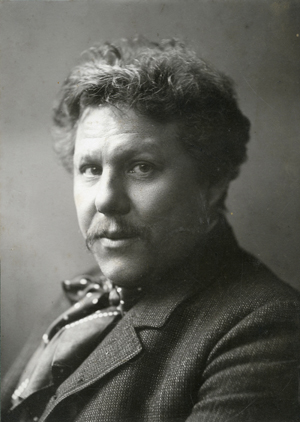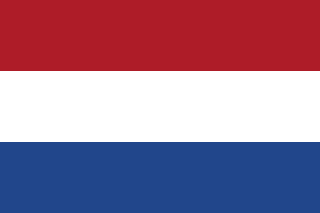Henri Florimond Goovaerts
13 November 1865 – 23 August 1912
Henri Florimond Goovaerts was born in Maastricht, where he grew up with his father and mother and his nine brothers and sisters at Markt 25. He was the eldest son of a decorative painter and immediately after primary school, began to help his father by painting ornaments on ceilings in the small castles and distinguished houses of Maastricht. The family in which Henri grew up was a lively one. His father, with his dark tousled hair that gave him a bohemian look, was a gifted storyteller, and the Goovaerts children's favourite activities consisted of recitals and improvising little plays. They soon found themselves in the company of their neighbouring boys who later became writer Fons Olterdissen and musician Guus Olterdissen. Henri's ambition at a young age was to become a painter. In the evenings and on Sundays he practised drawing and painting, while he helped his father in his painting business during the day. The oldest known painting, dating from 1881, shows that Henri Goovaerts was already very talented at the age of sixteen. At eighteen he moved to Mechelen (Belgium), where he started at the art academy and is taught by, among others, the then director Willem Geets. During his training, he won several prizes for drawing objects such as antique figures and from nature. Two years after completing this course, he was admitted to the Rijksacademie van Beeldende Kunsten (State academy for the arts) in Amsterdam through Joseph Alberdingk Thijm, who was then a professor there. During his studies from 1887 to 1889, he entered for the Prix de Rome scholarship several times. In 1890 he finally won the coveted prize with the painting 'Dido'. The prize was a study trip through Italy and Spain where he was commissioned to copy works by the great masters, among other things. In Spain, well known Dutch artist, Jozef Israëls, who was also travelling through Spain at the time, recorded how Henri Goovaerts, 'armed with palette and brushes, descends from a high scaffold' in one of the rooms in the Prado, to introduce himself to Israëls. After his study trip, Henri Goovaerts returned to Maastricht in 1894 and set up a studio in the small chapel at 7 De Bosquetplein. Many of the works he made in Italy and Spain grace the walls. Tapestries, Persian carpets, old weapon collections and a lot of copperware create the romantic atmosphere which was associated with being an artist in those days. It is here that Goovaerts starts to focus on portraiture. He is commissioned to portray the local nobility and dignitaries. At the Markt in Maastricht, he has a second small studio where he paints mayors from Maastricht's history from old pictures and drawings. Now and then, he also receives other commissions. For instance, he paints the painting 'Charitas' for the town council of Maastricht, which is offered to Queen Regent Emma on her visit to the city in 1895. Soon, commissions from abroad come in as well. During his study trip, Henri Goovaerts met Hermann Schmitz, a high government official of the State of Hamburg and a wealthy art lover. He recognized Henri's talent and decided to help him. In 1896, Schmitz gave him a number of portrait commissions in Essen and Mülheim on the Ruhr. While portraying the Von Waldthausen family in Essen, he met Lily Meyer, who was a governess there. Two years later they were married in Düsseldorf. In 1897 Henri Goovaerts founds a drawing school in Maastricht with his own funds, which soon becomes a success. He not only gives drawing lessons, but also lectures on art history on Thursday evenings, which are well attended. With the school, Henri Goovaerts wants to offer a solid education to craftsmen. After the school trained sixty pupils within a year, Goovaerts tries to convince the city of Maastricht that there is a need for such a drawing school on the part of the municipality. In a letter to the city council, he argues that good drawing lessons are necessary for a joiner or a blacksmith to quickly and clearly show on paper what he can make. The municipality then decides to found the Stadstekeninstituut, the predecessor of the present Maastricht Academy of Arts. Henri Goovaerts hoped to become its director, but the municipality appointed an architect as its director and offered him a job as a drawing teacher. Disappointed, he declines the offer and leaves for Düsseldorf. During the last years of the 19th century, Henri Goovaerts lived and worked partly in Düsseldorf and partly in Maastricht. In addition, he travelled to Hamburg once in a while to paint portraits or copies of famous masters, commissioned by his patron Hermann Schmitz. In 1900, the Mülheim merchant Karl Schmitz-Scholl commissioned Goovaerts to copy a number of paintings from the Louvre in Paris. With his wife and their one-year-old son Hans, Henri Goovaerts left for Paris in January 1901, where the family moved into an apartment on the Rue Fontaine. During the day he worked at the Louvre making copies of Titian, Watteau and Rembrandt, and in the evening he visited the Académie Julian where he drew and painted from living models. Not long after the period in Paris, Henri Goovaerts is asked to paint a number of portraits of rich industrialists and their families in Switzerland. Meanwhile, his second son Heinz has been born and the Goovaerts family moves to the highlands of Zurich, which at that moment are the centre of a flourishing textile industry. Henri Goovaerts was offered the country house of one of the manufacturers' families as accommodation. Here he set up a small studio. He probably painted about twenty portraits and also produced other work. The three years he spent in Switzerland were among the happiest of his life. He was a welcome guest in the circle of his patrons and made a number of special trips through the Alpine region that made a big impression on him. When he returned to Maastricht in 1905, he intended to settle there permanently. He and his family moved into a house on the Papenweg in Sint Pieter, and he had a large studio built next to it. In 1906, an exhibition of international visual arts was organized in Maastricht. Henri Goovaerts wins first prize: a silver medal from the hands of Prince Hendrik of the Netherlands. In 1908, his third son Frits is born. The portrait commissions keep coming. Sometimes he has to go to Hamburg for a short time, such as for the portrait of the writer Ida Boy-Ed. In the meantime, he sets up a painting school on the Heinrichsallee in Aachen. In the accompanying studio, he paints among others the portraits of the sculptor Karl Krauß and of Hermann Schweitzer, the director of the Suermondt Museum in Aachen. In the last two years of his life, heart problems make it difficult to work. Henri Goovaerts dies of heart failure at the age of 46. At that time, he has at least three paintings in progress: two portraits of women and a painting of the Maastricht Municipal Civic Guard. The portraits of the women, which are almost finished when Goovaerts dies, are bought by the patrons. The painting of the city militia was completed by the Maastricht painters Henri Jonas, Robert Graafland and Guillaume Eberhard. Henri Goovaerts is buried in the Maastricht General Cemetery. Maastricht sculptor Gerard Hack made the grave monument. In 1933, it was decided to name a street after him in Maastricht: the Henri Goovaertsweg. The road is located on Sint Pieter, in the south of the city on the left bank of the Maas. During his short life, Henri Goovaerts lived and worked in Maastricht, Mechelen, Düsseldorf, Essen, Aachen, Hamburg, Paris and various places in Italy, Spain and Switzerland. As a result, his work is spread across several European countries. Most of Henri Goovaerts' work is in the possession of private persons. A small part can be found in domestic and foreign museums. The current whereabouts of a considerable number of works is still unknown to us today.


